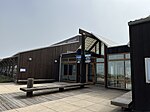Elkhorn Slough
Bodies of water of Monterey County, CaliforniaDrainage basins of Monterey BayEstuaries of CaliforniaImportant Bird Areas of CaliforniaLandforms of Monterey County, California ... and 3 more
Protected areas of Monterey County, CaliforniaRamsar sites in the United StatesUse mdy dates from February 2024

Elkhorn Slough is a 7-mile-long (11 km) tidal slough and estuary on Monterey Bay in Monterey County, California. It is California's second largest estuary and the United States' first estuarine sanctuary. The community of Moss Landing and the Moss Landing Power Plant are located at the mouth of the slough on the bay. Elkhorn Slough harbors the largest tract of tidal salt marsh in California outside the San Francisco Bay and provides much-needed habitat for hundreds of species of plants and animals, including more than 340 species of birds. It has been designated as a protected Ramsar site since 2018.
Excerpt from the Wikipedia article Elkhorn Slough (License: CC BY-SA 3.0, Authors, Images).Elkhorn Slough
Dolan Road,
Geographical coordinates (GPS) Address Nearby Places Show on map
Geographical coordinates (GPS)
| Latitude | Longitude |
|---|---|
| N 36.816666666667 ° | E -121.76666666667 ° |
Address
Sea otters
Dolan Road
95039
California, United States
Open on Google Maps








